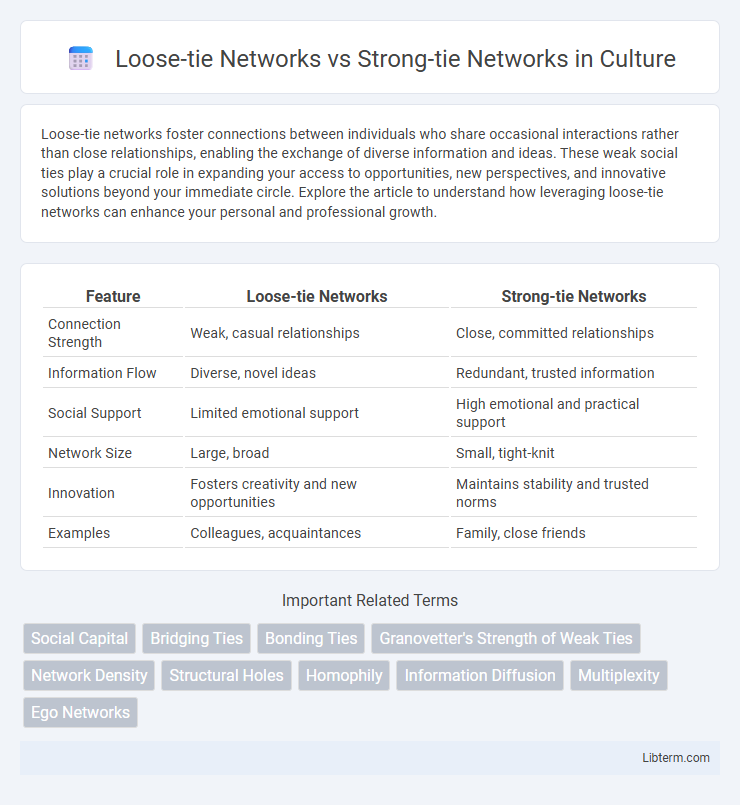Loose-tie networks foster connections between individuals who share occasional interactions rather than close relationships, enabling the exchange of diverse information and ideas. These weak social ties play a crucial role in expanding your access to opportunities, new perspectives, and innovative solutions beyond your immediate circle. Explore the article to understand how leveraging loose-tie networks can enhance your personal and professional growth.
Table of Comparison
| Feature | Loose-tie Networks | Strong-tie Networks |
|---|---|---|
| Connection Strength | Weak, casual relationships | Close, committed relationships |
| Information Flow | Diverse, novel ideas | Redundant, trusted information |
| Social Support | Limited emotional support | High emotional and practical support |
| Network Size | Large, broad | Small, tight-knit |
| Innovation | Fosters creativity and new opportunities | Maintains stability and trusted norms |
| Examples | Colleagues, acquaintances | Family, close friends |
Understanding Loose-tie and Strong-tie Networks
Loose-tie networks consist of casual, infrequent social connections that facilitate access to diverse information and novel opportunities, enhancing innovation and knowledge dissemination. Strong-tie networks are characterized by close, frequent interactions and mutual trust, providing emotional support, collaboration, and reliable resource-sharing. Understanding the balance between loose-tie and strong-tie networks is crucial for optimizing social capital and achieving both creativity and stability in personal and professional relationships.
Key Characteristics of Loose-tie Networks
Loose-tie networks are characterized by weak, infrequent connections between diverse individuals, facilitating access to novel information and broad social capital. These networks enable rapid dissemination of new ideas and foster innovation by bridging otherwise disconnected social groups. Unlike strong-tie networks, loose ties provide flexibility and versatility without the emotional intensity or trust typically found in close relationships.
Defining Features of Strong-tie Networks
Strong-tie networks are characterized by close-knit relationships with frequent interactions and high emotional intensity, often found among family members and close friends. These networks exhibit strong trust, mutual support, and shared norms, fostering reliable communication and collaboration. The dense connectivity typical of strong-tie networks enhances cohesion but may limit access to novel information compared to loose-tie networks.
Formation and Maintenance of Network Ties
Loose-tie networks form through infrequent, casual interactions often across diverse social or professional groups, enabling access to novel information and broader opportunities. Strong-tie networks develop from frequent, emotionally intense interactions characterized by trust and mutual support, which facilitate reliable resource exchange and cooperation. The maintenance of loose ties requires occasional communication and shared contexts, while strong ties demand continuous interaction and emotional engagement to sustain relational depth.
Information Flow in Loose vs Strong-tie Networks
Loose-tie networks facilitate faster information flow by connecting diverse groups, enabling access to novel, non-redundant information critical for innovation and problem-solving. Strong-tie networks, characterized by close-knit relationships, often result in redundant information circulation but foster trust and efficient collaboration through frequent interactions. The balance between loose and strong ties determines the richness and speed of information diffusion within social and organizational contexts.
Advantages of Loose-tie Connections
Loose-tie networks offer significant advantages by providing access to diverse information and novel opportunities through weak, infrequent connections that bridge different social groups. These connections enhance innovation and adaptability by exposing individuals to unique perspectives and broader knowledge pools beyond their immediate close-knit circles. Organizations leveraging loose-tie networks benefit from improved problem-solving capabilities and increased reach in professional and social contexts.
Benefits of Strong-tie Relationships
Strong-tie relationships foster deep trust, emotional support, and reliable collaboration, which drive effective teamwork and resilience in social or organizational settings. These networks enable rapid information sharing and reinforce shared norms, enhancing cohesion and long-term cooperation. Close-knit connections also provide a safety net during crises, promoting stability and mutual assistance.
Challenges in Managing Different Network Types
Managing loose-tie networks poses challenges such as maintaining engagement and ensuring information flow across diverse, weak connections prone to infrequent contact. Strong-tie networks require balancing deep, trust-based relationships with risks of groupthink and resistance to new ideas. Leaders must navigate these dynamics by fostering openness in strong ties while encouraging active participation and relevance in loose ties.
Practical Examples: Loose-tie vs Strong-tie Networks
Loose-tie networks are common in professional settings where acquaintances share industry knowledge or job leads, such as LinkedIn connections or conference attendees, enabling broader information flow and innovation. Strong-tie networks include close-knit family, friends, or coworkers who provide emotional support and trusted advice, crucial in crisis situations or collaborative projects requiring high trust. In startups, loose ties facilitate access to diverse markets and ideas, while strong ties help maintain company culture and cohesive teams.
Choosing the Right Network for Your Goals
Loose-tie networks consist of weak social connections that offer access to diverse information and new opportunities, making them ideal for innovation, job searching, and knowledge expansion. Strong-tie networks, formed by close relationships like family and close friends, provide emotional support, trust, and reliable resources, suitable for personal support and collaboration on long-term projects. Selecting the right network depends on goals: prioritize loose ties for broad outreach and strong ties for depth and stability in relationships.
Loose-tie Networks Infographic

 libterm.com
libterm.com